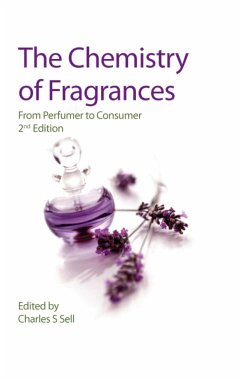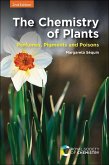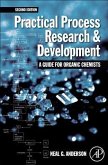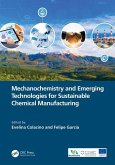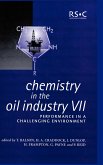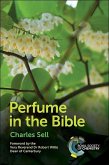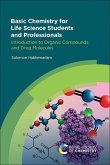Charles Sell (ed.)
Chemistry of Fragrances
From Perfumer to Consumer
Herausgeber: Pybus, David H; Sell, Charles S
Charles Sell (ed.)
Chemistry of Fragrances
From Perfumer to Consumer
Herausgeber: Pybus, David H; Sell, Charles S
- Gebundenes Buch
- Merkliste
- Auf die Merkliste
- Bewerten Bewerten
- Teilen
- Produkt teilen
- Produkterinnerung
- Produkterinnerung
This unique book gives an insider view of "mixing molecules" from behind the portals of modern-day alchemy. It will be enjoyed by chemists and marketeers at all levels.
Andere Kunden interessierten sich auch für
![Chemistry of Plants Chemistry of Plants]() Margareta Sequin (USA San Francisco State University)Chemistry of Plants42,99 €
Margareta Sequin (USA San Francisco State University)Chemistry of Plants42,99 €![Practical Process Research and Development - A Guide for Organic Chemists Practical Process Research and Development - A Guide for Organic Chemists]() Neal G. AndersonPractical Process Research and Development - A Guide for Organic Chemists140,99 €
Neal G. AndersonPractical Process Research and Development - A Guide for Organic Chemists140,99 €![Organic Synthesis Using Biocatalysis Organic Synthesis Using Biocatalysis]() Organic Synthesis Using Biocatalysis165,99 €
Organic Synthesis Using Biocatalysis165,99 €![Mechanochemistry and Emerging Technologies for Sustainable Chemical Manufacturing Mechanochemistry and Emerging Technologies for Sustainable Chemical Manufacturing]() Mechanochemistry and Emerging Technologies for Sustainable Chemical Manufacturing172,99 €
Mechanochemistry and Emerging Technologies for Sustainable Chemical Manufacturing172,99 €![Chemistry in the Oil Industry VII Chemistry in the Oil Industry VII]() BalsonChemistry in the Oil Industry VII122,99 €
BalsonChemistry in the Oil Industry VII122,99 €![Perfume in the Bible Perfume in the Bible]() Charles S SellPerfume in the Bible29,99 €
Charles S SellPerfume in the Bible29,99 €![Basic Chemistry for Life Science Students and Professionals Basic Chemistry for Life Science Students and Professionals]() Solomon Habtemariam (UK University of Greenwich)Basic Chemistry for Life Science Students and Professionals61,99 €
Solomon Habtemariam (UK University of Greenwich)Basic Chemistry for Life Science Students and Professionals61,99 €-
-
-
This unique book gives an insider view of "mixing molecules" from behind the portals of modern-day alchemy. It will be enjoyed by chemists and marketeers at all levels.
Hinweis: Dieser Artikel kann nur an eine deutsche Lieferadresse ausgeliefert werden.
Hinweis: Dieser Artikel kann nur an eine deutsche Lieferadresse ausgeliefert werden.
Produktdetails
- Produktdetails
- Verlag: Royal Society of Chemistry
- Artikelnr. des Verlages: 11753841
- 2 ed
- Seitenzahl: 348
- Erscheinungstermin: 6. November 2006
- Englisch
- Abmessung: 235mm x 156mm x 24mm
- Gewicht: 646g
- ISBN-13: 9780854048243
- ISBN-10: 0854048243
- Artikelnr.: 24600356
- Herstellerkennzeichnung
- Produktsicherheitsverantwortliche/r
- Europaallee 1
- 36244 Bad Hersfeld
- gpsr@libri.de
- Verlag: Royal Society of Chemistry
- Artikelnr. des Verlages: 11753841
- 2 ed
- Seitenzahl: 348
- Erscheinungstermin: 6. November 2006
- Englisch
- Abmessung: 235mm x 156mm x 24mm
- Gewicht: 646g
- ISBN-13: 9780854048243
- ISBN-10: 0854048243
- Artikelnr.: 24600356
- Herstellerkennzeichnung
- Produktsicherheitsverantwortliche/r
- Europaallee 1
- 36244 Bad Hersfeld
- gpsr@libri.de
Charles Sell is a Visiting Scientist at Massachusetts Institute of Technology, Boston and has 30 years' research experience in fragrance with Quest International.
Acknowledgement
Glossary
Chapter 1: The Human Relationship with Fragrance
Chapter 2: The History of Aroma Chemistry and Perfume
2.1: Early Use of Fragrance
2.2: The Age of Chivalry
2.3: The Age of Alchemy
2.4: The Age of Discovery
2.5: The Age of Revolution
2.6: The Age of Empire (Nineteenth Century)
2.7: The Age of Fashion (Twentieth Century)
Chapter 3: Perfumery Materials of Natural Origin
3.1: Perfumes and Odours in Nature
3.2: Extraction of Natural Perfume Ingredients
3.3: Adulteration of Natural Perfume Ingredients
3.4: From Natural to Synthetic
References
Chapter 4: Ingredients for the Modern Perfumery Industry
4.1: Economic Factors Affecting Perfume Ingredient Production
4.2: Perfume Ingredients Derived from Terpenoids
4.3: Musks
4.4: Perfume Ingredients Derived from Benzene
4.5: Perfume Ingredients Derived from Toluene
4.6: Perfume Ingredients Derived from Phenol
4.7: Pefrume Ingredients Derived from Naphthalene
4.8: Perfume Ingredients Derived from Aliphatic Materials
4.9: Perfume Ingredients Derived from Cyclopentanone
4.10: Perfume Ingredients Derived from Dicyclopentadiene
4.11: Conclusions
References
Chapter 5: The Structure of an International Fragrance Company
5.1: The Business-Getting Chain
5.2: The Supply Chain
References
Chapter 6: The Perfume Brief
6.1: Brief for Eve - Prepared by Business Scents Ltd
6.2: Toxicology
Chapter 7: Perfumer Creation: The Role of the Perfumer
7.1: Soap
7.2: Shampoo
7.3: Shower and Bath Gel
7.4: Antiperspirant
Reference
Chapter 8: Measurement of Fragrance Perception
8.1: Introduction
8.2: Market Research
8.3: Sensory Analysis
8.4: Multisensory Approach
8.5: Psychology of Perfume
8.6: The Business Scents Brief
8.7: Analysis of Ingredients to Convey the Appropriate Odour Characteristics
8.8: Creating Fragrances for the Future
References
Chapter 9: The Application of Fragrance
9.1: The Role of the Applications Department
9.2: Product Formulations
9.3: Stability Testing
References
Chapter 10: The Safety and Toxicology of Fragrances
10.1: Introduction
10.2: Self Regulation
10.3: Safety Assessment
10.4: Skin Irritation
10.5: Skin Sensitisation
10.6: Photoeffects
10.7: Neurotoxicity
10.8: Reproductive Effects
10.9: Natural Ingredients
10.10: Conclusions
References
Chapter 11: Volatility and Substantivity
11.1: Perfume Creation and Physical Chemistry
11.2: Perfume Ingredient Volatility
11.3: Perfume Polarity
11.4: Substantivity and Retention
11.5: Conclusions
References
Chapter 12: Natural Product Analysis in the Fragrance Industry
12.1: Introduction
12.2: Natural Product Analysis
12.3: Analytical Techniques used in the Fragrance Industry
12.4: Positive Identification
12.5: Headspace Collection
12.6: The Future
References
Chapter 13: Chemoreception
13.1: Why have a Sense of Smell?
13.2: Measuring Smell
13.3: Cell Wall Structure
13.4: Proteins Involved in Signal Generation
13.5: Anatomy of Smell
13.6: Signal Generation
13.7: The Combinatorial Nature of Odour Perception
13.8: Signal Processing
13.9: Implications for Odorant Design
References
Chapter 14: The Search for New Ingredients
14.1: Introduction
14.2: The Need
14.3: The Search
14.4: Computer-Aided Design Approach
14.5: Summary
Acknowledgements
References
Chapter 15: Buying Fragrance Ingredients and Selling Fragrance Compounds
15.1: Buying
15.2: Sales and Marketing
Chapter 16: The Finale: Brief Submission
Appendix I: Some of the more Important Natural Fragrance Materials
Appendix II: Useful Addresses
Bibliography
Subject Index
Glossary
Chapter 1: The Human Relationship with Fragrance
Chapter 2: The History of Aroma Chemistry and Perfume
2.1: Early Use of Fragrance
2.2: The Age of Chivalry
2.3: The Age of Alchemy
2.4: The Age of Discovery
2.5: The Age of Revolution
2.6: The Age of Empire (Nineteenth Century)
2.7: The Age of Fashion (Twentieth Century)
Chapter 3: Perfumery Materials of Natural Origin
3.1: Perfumes and Odours in Nature
3.2: Extraction of Natural Perfume Ingredients
3.3: Adulteration of Natural Perfume Ingredients
3.4: From Natural to Synthetic
References
Chapter 4: Ingredients for the Modern Perfumery Industry
4.1: Economic Factors Affecting Perfume Ingredient Production
4.2: Perfume Ingredients Derived from Terpenoids
4.3: Musks
4.4: Perfume Ingredients Derived from Benzene
4.5: Perfume Ingredients Derived from Toluene
4.6: Perfume Ingredients Derived from Phenol
4.7: Pefrume Ingredients Derived from Naphthalene
4.8: Perfume Ingredients Derived from Aliphatic Materials
4.9: Perfume Ingredients Derived from Cyclopentanone
4.10: Perfume Ingredients Derived from Dicyclopentadiene
4.11: Conclusions
References
Chapter 5: The Structure of an International Fragrance Company
5.1: The Business-Getting Chain
5.2: The Supply Chain
References
Chapter 6: The Perfume Brief
6.1: Brief for Eve - Prepared by Business Scents Ltd
6.2: Toxicology
Chapter 7: Perfumer Creation: The Role of the Perfumer
7.1: Soap
7.2: Shampoo
7.3: Shower and Bath Gel
7.4: Antiperspirant
Reference
Chapter 8: Measurement of Fragrance Perception
8.1: Introduction
8.2: Market Research
8.3: Sensory Analysis
8.4: Multisensory Approach
8.5: Psychology of Perfume
8.6: The Business Scents Brief
8.7: Analysis of Ingredients to Convey the Appropriate Odour Characteristics
8.8: Creating Fragrances for the Future
References
Chapter 9: The Application of Fragrance
9.1: The Role of the Applications Department
9.2: Product Formulations
9.3: Stability Testing
References
Chapter 10: The Safety and Toxicology of Fragrances
10.1: Introduction
10.2: Self Regulation
10.3: Safety Assessment
10.4: Skin Irritation
10.5: Skin Sensitisation
10.6: Photoeffects
10.7: Neurotoxicity
10.8: Reproductive Effects
10.9: Natural Ingredients
10.10: Conclusions
References
Chapter 11: Volatility and Substantivity
11.1: Perfume Creation and Physical Chemistry
11.2: Perfume Ingredient Volatility
11.3: Perfume Polarity
11.4: Substantivity and Retention
11.5: Conclusions
References
Chapter 12: Natural Product Analysis in the Fragrance Industry
12.1: Introduction
12.2: Natural Product Analysis
12.3: Analytical Techniques used in the Fragrance Industry
12.4: Positive Identification
12.5: Headspace Collection
12.6: The Future
References
Chapter 13: Chemoreception
13.1: Why have a Sense of Smell?
13.2: Measuring Smell
13.3: Cell Wall Structure
13.4: Proteins Involved in Signal Generation
13.5: Anatomy of Smell
13.6: Signal Generation
13.7: The Combinatorial Nature of Odour Perception
13.8: Signal Processing
13.9: Implications for Odorant Design
References
Chapter 14: The Search for New Ingredients
14.1: Introduction
14.2: The Need
14.3: The Search
14.4: Computer-Aided Design Approach
14.5: Summary
Acknowledgements
References
Chapter 15: Buying Fragrance Ingredients and Selling Fragrance Compounds
15.1: Buying
15.2: Sales and Marketing
Chapter 16: The Finale: Brief Submission
Appendix I: Some of the more Important Natural Fragrance Materials
Appendix II: Useful Addresses
Bibliography
Subject Index
Acknowledgement
Glossary
Chapter 1: The Human Relationship with Fragrance
Chapter 2: The History of Aroma Chemistry and Perfume
2.1: Early Use of Fragrance
2.2: The Age of Chivalry
2.3: The Age of Alchemy
2.4: The Age of Discovery
2.5: The Age of Revolution
2.6: The Age of Empire (Nineteenth Century)
2.7: The Age of Fashion (Twentieth Century)
Chapter 3: Perfumery Materials of Natural Origin
3.1: Perfumes and Odours in Nature
3.2: Extraction of Natural Perfume Ingredients
3.3: Adulteration of Natural Perfume Ingredients
3.4: From Natural to Synthetic
References
Chapter 4: Ingredients for the Modern Perfumery Industry
4.1: Economic Factors Affecting Perfume Ingredient Production
4.2: Perfume Ingredients Derived from Terpenoids
4.3: Musks
4.4: Perfume Ingredients Derived from Benzene
4.5: Perfume Ingredients Derived from Toluene
4.6: Perfume Ingredients Derived from Phenol
4.7: Pefrume Ingredients Derived from Naphthalene
4.8: Perfume Ingredients Derived from Aliphatic Materials
4.9: Perfume Ingredients Derived from Cyclopentanone
4.10: Perfume Ingredients Derived from Dicyclopentadiene
4.11: Conclusions
References
Chapter 5: The Structure of an International Fragrance Company
5.1: The Business-Getting Chain
5.2: The Supply Chain
References
Chapter 6: The Perfume Brief
6.1: Brief for Eve - Prepared by Business Scents Ltd
6.2: Toxicology
Chapter 7: Perfumer Creation: The Role of the Perfumer
7.1: Soap
7.2: Shampoo
7.3: Shower and Bath Gel
7.4: Antiperspirant
Reference
Chapter 8: Measurement of Fragrance Perception
8.1: Introduction
8.2: Market Research
8.3: Sensory Analysis
8.4: Multisensory Approach
8.5: Psychology of Perfume
8.6: The Business Scents Brief
8.7: Analysis of Ingredients to Convey the Appropriate Odour Characteristics
8.8: Creating Fragrances for the Future
References
Chapter 9: The Application of Fragrance
9.1: The Role of the Applications Department
9.2: Product Formulations
9.3: Stability Testing
References
Chapter 10: The Safety and Toxicology of Fragrances
10.1: Introduction
10.2: Self Regulation
10.3: Safety Assessment
10.4: Skin Irritation
10.5: Skin Sensitisation
10.6: Photoeffects
10.7: Neurotoxicity
10.8: Reproductive Effects
10.9: Natural Ingredients
10.10: Conclusions
References
Chapter 11: Volatility and Substantivity
11.1: Perfume Creation and Physical Chemistry
11.2: Perfume Ingredient Volatility
11.3: Perfume Polarity
11.4: Substantivity and Retention
11.5: Conclusions
References
Chapter 12: Natural Product Analysis in the Fragrance Industry
12.1: Introduction
12.2: Natural Product Analysis
12.3: Analytical Techniques used in the Fragrance Industry
12.4: Positive Identification
12.5: Headspace Collection
12.6: The Future
References
Chapter 13: Chemoreception
13.1: Why have a Sense of Smell?
13.2: Measuring Smell
13.3: Cell Wall Structure
13.4: Proteins Involved in Signal Generation
13.5: Anatomy of Smell
13.6: Signal Generation
13.7: The Combinatorial Nature of Odour Perception
13.8: Signal Processing
13.9: Implications for Odorant Design
References
Chapter 14: The Search for New Ingredients
14.1: Introduction
14.2: The Need
14.3: The Search
14.4: Computer-Aided Design Approach
14.5: Summary
Acknowledgements
References
Chapter 15: Buying Fragrance Ingredients and Selling Fragrance Compounds
15.1: Buying
15.2: Sales and Marketing
Chapter 16: The Finale: Brief Submission
Appendix I: Some of the more Important Natural Fragrance Materials
Appendix II: Useful Addresses
Bibliography
Subject Index
Glossary
Chapter 1: The Human Relationship with Fragrance
Chapter 2: The History of Aroma Chemistry and Perfume
2.1: Early Use of Fragrance
2.2: The Age of Chivalry
2.3: The Age of Alchemy
2.4: The Age of Discovery
2.5: The Age of Revolution
2.6: The Age of Empire (Nineteenth Century)
2.7: The Age of Fashion (Twentieth Century)
Chapter 3: Perfumery Materials of Natural Origin
3.1: Perfumes and Odours in Nature
3.2: Extraction of Natural Perfume Ingredients
3.3: Adulteration of Natural Perfume Ingredients
3.4: From Natural to Synthetic
References
Chapter 4: Ingredients for the Modern Perfumery Industry
4.1: Economic Factors Affecting Perfume Ingredient Production
4.2: Perfume Ingredients Derived from Terpenoids
4.3: Musks
4.4: Perfume Ingredients Derived from Benzene
4.5: Perfume Ingredients Derived from Toluene
4.6: Perfume Ingredients Derived from Phenol
4.7: Pefrume Ingredients Derived from Naphthalene
4.8: Perfume Ingredients Derived from Aliphatic Materials
4.9: Perfume Ingredients Derived from Cyclopentanone
4.10: Perfume Ingredients Derived from Dicyclopentadiene
4.11: Conclusions
References
Chapter 5: The Structure of an International Fragrance Company
5.1: The Business-Getting Chain
5.2: The Supply Chain
References
Chapter 6: The Perfume Brief
6.1: Brief for Eve - Prepared by Business Scents Ltd
6.2: Toxicology
Chapter 7: Perfumer Creation: The Role of the Perfumer
7.1: Soap
7.2: Shampoo
7.3: Shower and Bath Gel
7.4: Antiperspirant
Reference
Chapter 8: Measurement of Fragrance Perception
8.1: Introduction
8.2: Market Research
8.3: Sensory Analysis
8.4: Multisensory Approach
8.5: Psychology of Perfume
8.6: The Business Scents Brief
8.7: Analysis of Ingredients to Convey the Appropriate Odour Characteristics
8.8: Creating Fragrances for the Future
References
Chapter 9: The Application of Fragrance
9.1: The Role of the Applications Department
9.2: Product Formulations
9.3: Stability Testing
References
Chapter 10: The Safety and Toxicology of Fragrances
10.1: Introduction
10.2: Self Regulation
10.3: Safety Assessment
10.4: Skin Irritation
10.5: Skin Sensitisation
10.6: Photoeffects
10.7: Neurotoxicity
10.8: Reproductive Effects
10.9: Natural Ingredients
10.10: Conclusions
References
Chapter 11: Volatility and Substantivity
11.1: Perfume Creation and Physical Chemistry
11.2: Perfume Ingredient Volatility
11.3: Perfume Polarity
11.4: Substantivity and Retention
11.5: Conclusions
References
Chapter 12: Natural Product Analysis in the Fragrance Industry
12.1: Introduction
12.2: Natural Product Analysis
12.3: Analytical Techniques used in the Fragrance Industry
12.4: Positive Identification
12.5: Headspace Collection
12.6: The Future
References
Chapter 13: Chemoreception
13.1: Why have a Sense of Smell?
13.2: Measuring Smell
13.3: Cell Wall Structure
13.4: Proteins Involved in Signal Generation
13.5: Anatomy of Smell
13.6: Signal Generation
13.7: The Combinatorial Nature of Odour Perception
13.8: Signal Processing
13.9: Implications for Odorant Design
References
Chapter 14: The Search for New Ingredients
14.1: Introduction
14.2: The Need
14.3: The Search
14.4: Computer-Aided Design Approach
14.5: Summary
Acknowledgements
References
Chapter 15: Buying Fragrance Ingredients and Selling Fragrance Compounds
15.1: Buying
15.2: Sales and Marketing
Chapter 16: The Finale: Brief Submission
Appendix I: Some of the more Important Natural Fragrance Materials
Appendix II: Useful Addresses
Bibliography
Subject Index

